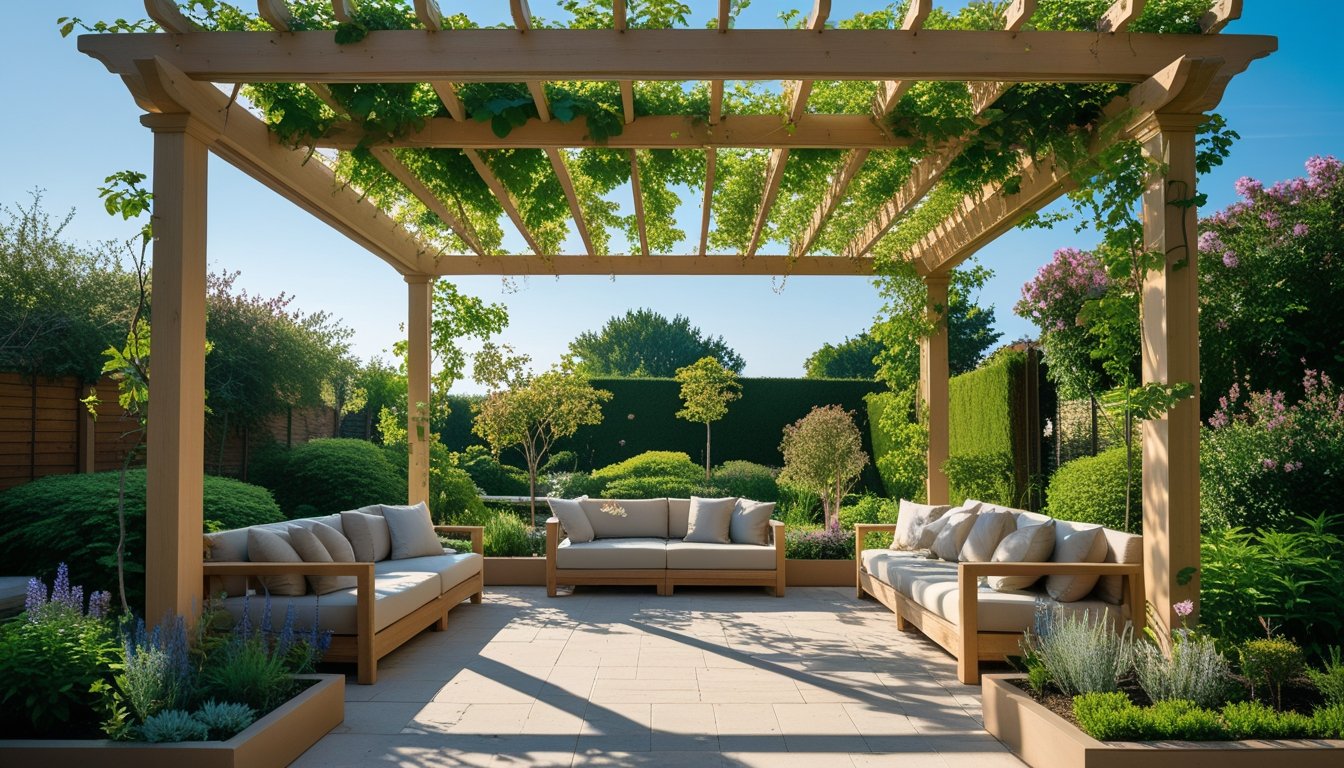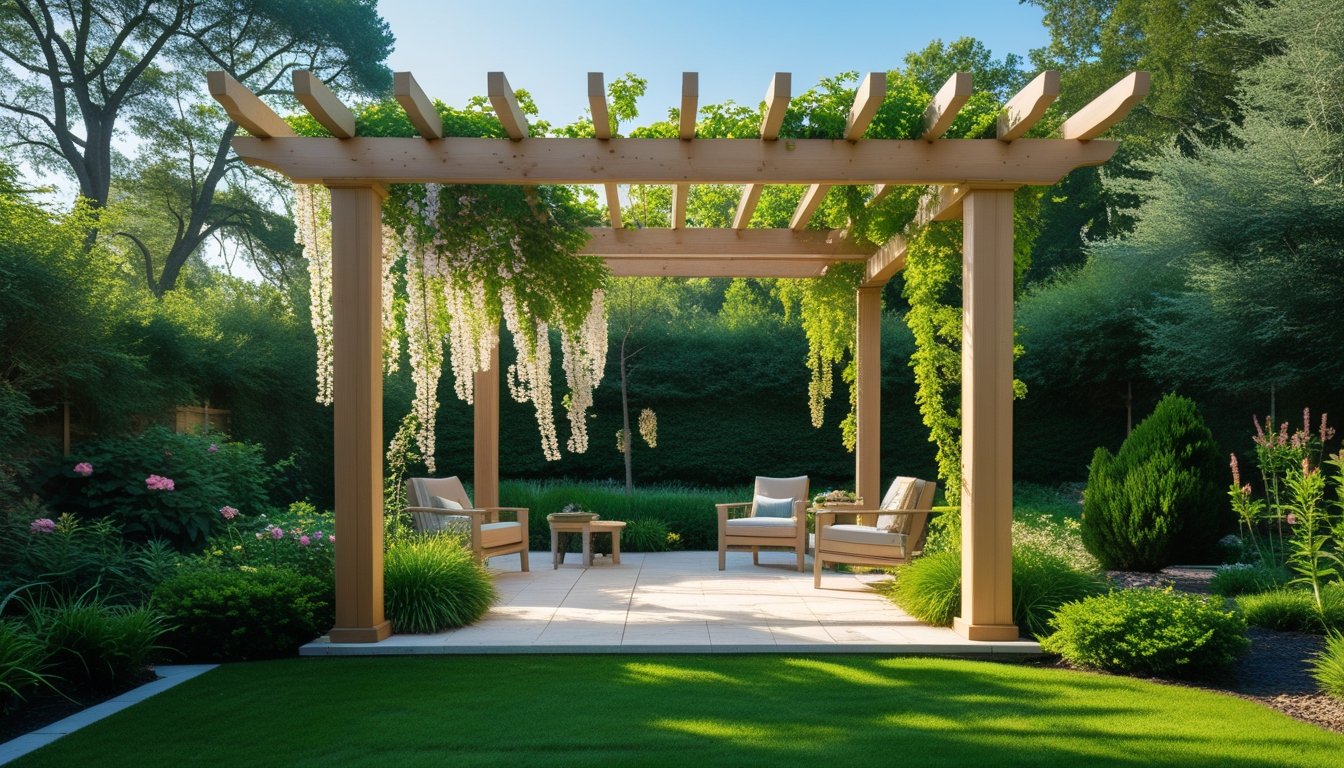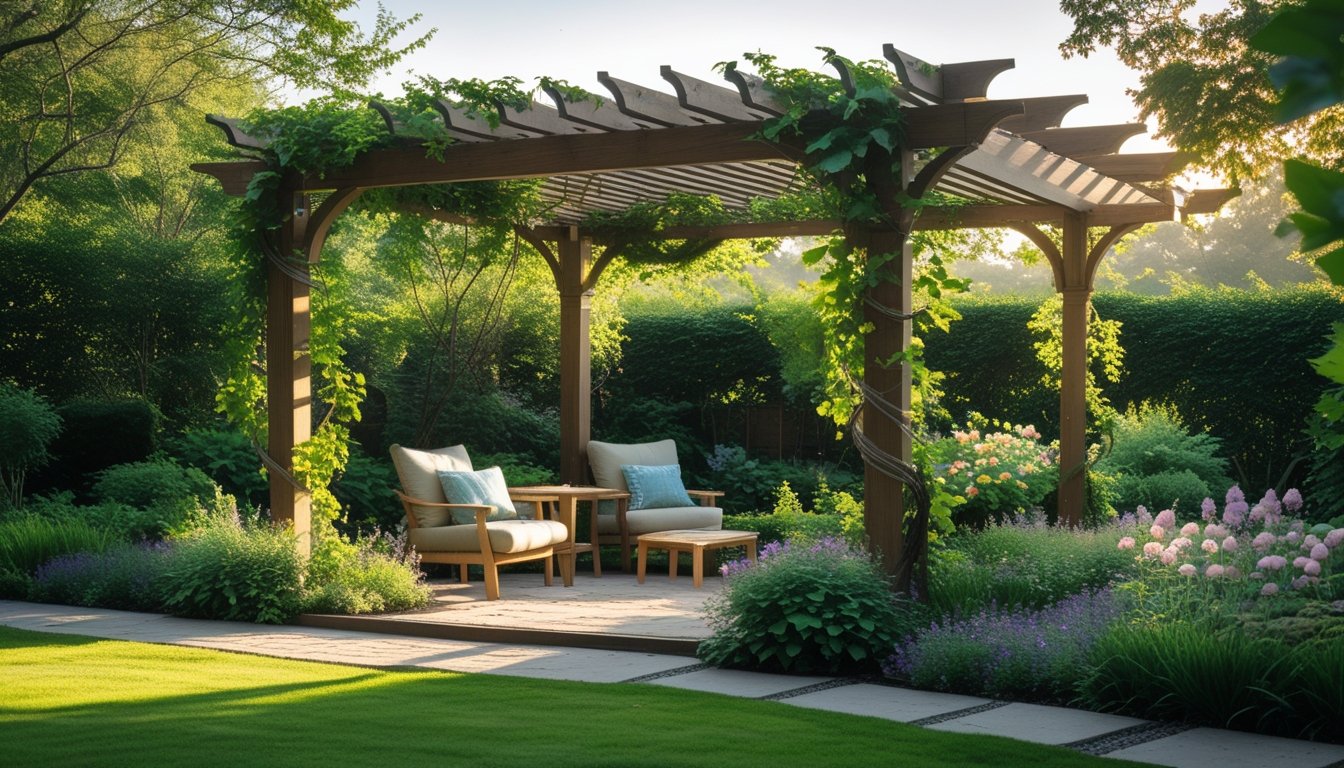Late updated: 09 Jun 2025 15:06
Written by: James Whitaker
Garden Pergola Design Ideas for Tranquil Outdoor Spaces: Inspire Your Backyard Transformation
Designing a tranquil outdoor space can transform your garden into a serene haven that merges with nature. A well-crafted pergola is not just an architectural feature; it is the cornerstone of this transformation. By carefully choosing elements such as flowing curtains, natural wood beams, and strategic placement, we can create a soothing retreat that invites relaxation.

Integrating a pergola into our garden not only enhances its aesthetic appeal but also elevates our outdoor living experience. By incorporating features like water fountains or fire pits, we can amplify the comfort and charm of our space. Whether nestled next to a Zen garden or accentuating a rustic setting, the pergola serves as a versatile focal point that accommodates a myriad of designs.
The allure of pergolas lies in their ability to adapt to various styles and preferences while promoting tranquillity. Through thoughtful design choices, we can certainly turn any part of our garden into a space of peace and elegance. Let us guide you through the essentials of pergola design and some inspiring ideas to create your own relaxing oasis.
Key Takeaways
- A well-designed pergola enhances a tranquil outdoor space.
- Incorporating elements like curtains and natural materials promotes relaxation.
- Strategic design choices elevate the outdoor living experience.
Fundamental Elements of Tranquil Garden Pergola Design

In creating a serene garden space with a pergola, the interplay of design, materials, and features is critical. We focus on the style, calming features, and construction elements that contribute to a peaceful outdoor retreat.
Choosing the Right Pergola Style
Selecting the perfect pergola style sets the tone for your tranquil outdoor haven. Classic white pergolas offer elegance and blend seamlessly into lush garden backdrops.
For a contemporary feel, a modern steel pergola with minimalist lines could be ideal. Those preferring an industrial look might opt for an industrial pergola featuring exposed beams and raw materials.
An arched pergola can also add a fluid and inviting look, while a freestanding pergola offers flexibility in placement, allowing us to create designated relaxation zones.
By aligning pergola styles with personal taste and garden aesthetics, we establish a harmonious environment that invites relaxation.
Essential Features for Serenity
Features that foster a peaceful atmosphere are key. Flowing curtains softly sway in the breeze, creating a sense of privacy and intimacy. Climbing vines, like wisteria or clematis, add natural beauty and fragrance, transforming the space into a verdant cocoon.
Hanging plants and string lights contribute to an enchanting environment, perfect for evening relaxation. Built-in seating enhances functionality, offering a cosy spot to unwind.
A retractable canopy or retractable roof provides flexibility with shade and sun, adapting to weather conditions and personal preference. These features are essential in maximising both comfort and aesthetic appeal.
Materials and Structural Considerations
Material choice significantly impacts the pergola's longevity and visual impact. Wooden pergolas exude warmth and natural appeal, particularly in a rustic setting.
For durability, steel pergolas serve well under varied weather conditions. They demand fewer maintenance efforts, which suits a modern or industrial aesthetic.
Whether opting for an attached pergola, linked to the home for convenience, or a freestanding one for versatile garden placement, structural integrity is paramount. Strong support beams and quality construction ensure the pergola stands the test of time, allowing us to enjoy our serene spaces for years to come.
Inspiring Pergola Ideas for Tranquil Outdoor Spaces
Creating a tranquil outdoor space with a pergola involves a marriage of design and functionality. From nature-inspired aesthetics to modern minimalist structures, the pergola ideas we explore here cater to diverse tastes. Whether enhancing with cultural themes or functional elements, these designs underscore the serenity and beauty that can transform any garden or patio.
Nature-Inspired and Classic Designs
Nature-inspired pergolas, such as a vine-covered or rustic wooden structure, evoke the beauty of the outdoors by integrating natural elements like climbing plants and timber. A classic white pergola offers an elegant touch and serves as a backdrop for lush greenery. Adding wooden beams and flowing white curtains can create a space reminiscent of a countryside charm, perfect for garden enthusiasts seeking serenity.
Modern and Minimalist Tranquil Pergolas
For those drawn to contemporary aesthetics, modern and minimalist pergola designs offer clean lines and simplicity. Structures made from materials like steel or aluminium can provide a sleek and sophisticated look. A minimalist pergola might feature a geometric form with ample open space underneath. These designs can be complemented with neutral-coloured furnishings, making them ideal for those who appreciate a clutter-free outdoor retreat.
Cultural and Thematic Styles
Cultural themes bring unique character to garden pergolas. An Asian-inspired style, like a Japanese pergola, pairs well with a Zen garden filled with rocks and tranquil water features. Mediterranean-style pergolas, using terracotta tiles and wrought iron, transport us to a sun-drenched coastal villa. For desert landscaping, a pergola with materials like adobe adds an earthy feel that harmonises with succulents and cacti.
Functional Enhancements for Relaxation
Incorporating functional features into pergolas extends their utility. Built-in seating and a retractable canopy increase comfort and protection. Integrating a fire pit or outdoor fireplace transforms the pergola into a warm gathering spot. Hammocks add leisure, while a pergola with fairy lights creates magic as twilight descends. These elements ensure that tranquillity is paired with convenience, perfect for evenings spent outdoors.
Patio and Poolside Pergola Solutions
Pergolas can enhance patio and pool areas by providing both shade and style. A poolside pergola can include retractable canopies that offer relief from the sun's glare. Patio pergola ideas focus on creating intimate nooks for relaxation or social gatherings. These structures can also serve as transition spaces from indoor to outdoor settings, blending seamlessly with the architecture of our home.
Creative DIY Pergola Approaches
For the do-it-yourself enthusiast, building a pergola can be a rewarding endeavour. Creating a DIY pergola opens avenues for customisation in size and style, using relevant materials like reclaimed wood for a rustic look or treated lumber for durability. This personalised approach allows for unique design elements and provides a sense of accomplishment, aligning the final product closely with personal vision.
Frequently Asked Questions

Incorporating a pergola into your garden space requires thoughtful planning and design. Selecting the right materials, understanding size proportions, and exploring decorative ideas with plants are key to creating a serene outdoor environment. Here, we address common queries about creating the perfect garden pergola.
What are some effective ways to make a small backyard pergola feel more intimate and secluded?
To create a sense of privacy, consider adding lightweight curtains or drapes that can be drawn when needed. Plant tall shrubs or climbing plants around the pergola's perimeter for natural seclusion. Using lattice panels as screens also enhances intimacy while allowing airflow.
How can one integrate a pergola into their garden to create a sense of tranquillity?
Position the pergola in a location that offers a peaceful view, such as near a water feature or surrounded by greenery. Incorporate calming elements like wind chimes or gentle lighting. The use of Zen garden elements like rocks or bamboo can also inspire serenity.
What considerations should be taken into account when choosing materials for constructing a pergola?
Consider the climate and the level of maintenance you are willing to perform. Wood offers a natural look but requires upkeep. Metal is durable but may not blend seamlessly with all garden styles. Ensure materials are weather-resistant and suit the aesthetic of your garden.
Could you suggest some creative ideas for decorating a pergola with plants?
Utilise climbing plants such as wisteria or jasmine to cover the pergola for a lush, green canopy. Hanging baskets or vertical planters add depth and colour. Consider pots with herbs or fragrant plants stationed around the base to enhance the multisensory experience.
What are the benefits of adding a roof to a garden pergola, and what options are available?
A roof provides additional shade and protection from the elements, extending the usability of the space. Options include retractable canopies, fixed roofs made from materials like polycarbonate, or a green roof with vegetation. Each offers varying degrees of light and weather resistance.
How can one achieve the ideal proportions when designing a pergola to ensure aesthetic harmony?
Keep the pergola in scale with the surrounding space and structures. The height should allow for comfortable movement beneath it, typically around 2 to 3 metres. Consider the balance between the width and depth, ensuring it complements both the house and garden layout.
